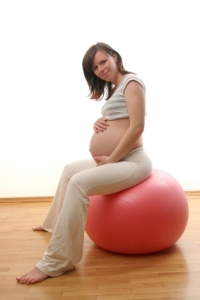Fitness
 Pregnancy & Training
Pregnancy & Training
It is common among pregnant woman to think that one will not be able to continue with exercise; once they have found out they are pregnant.
Pregnant woman can still continue their normal activities and exercise. It is important to establish what kind of exercise is suited during this time with the help of your doctor and fitness professional. Also note that there are specific risks and benefits to exercise and stay healthy.
When a woman becomes pregnant, her body starts changing. Changes are the abdominal wall and pelvic floor. This will influence balance, posture and spinal alignment.
Abdominal wall
The abdomen has no bony reinforcements. Abdomen muscles forms a corset that supports the growing uterus. There are so many names and insights to where all the different muscles connect. With this article it is not necessary to go into depth of the body’s biomechanics. Abdominals become stretched over the pregnant uterus. If these muscles become weakened through neglect or incorrect use, it could result in back pain due to less support in the back bone.
Pelvic floor changes
The levator ani and coccyqeus form the pelvic diaphragm. Pelvic diaphragm consists of rectum, urethra and vagina. During birth as baby passes through vagina the pelvic floor and the support sheet stretches and sometimes tears.
By exercising pelvic floor muscles you could reduce the risk of urinary incontinence, help with contracting muscles after birth, recover more quickly and reduce future problems.
Flexibility, Balance and Posture
During pregnancy the joints becomes more flexible because of the hormone relaxin. If not careful this could increase risk of injury during exercise.
Posture and balance change because of shift in the Centre of Gravity (COG). Vertebral curves changes because of COG that moves forward and upwards. It increases load on spine and woman tends to lean more on heels. This results in losing balance. With proper guidelines and exercise through a fitness specialist, posture and balance can be improved. Correct methods on how to stand, sitting down and lying down will be learned and could help for future back pains.
Lower Back Pain
Back pain is caused by the increasing weight which moves the spine forward increasing tension. Pregnant woman goes into a “lordosis state”. This means the Hollow Back. Exercise can help delay this process and help spinal alignment through stability and posture exercises.
For best results to maintain weight gain as baby grows, you need to consult with your Gynecologist, GP, Nutritionist and Fitness Specialist. After birth pelvic floor muscles needs to be strengthened to regain proper bladder control.
Reasons to exercise while being Pregnant.
- Improves circulation & blood flow.
- Helps with proper weight gain.
- Controls body fat percentage.
- Improves post partum muscle tone.
- Decreases constipation.
- Increases energy levels.
- Help you to sleep better.
- Decreases stress and tension.
- Improves appearance.
- Improve cardiovascular system to help ease delivery.
- Reduce need for C-section. (If there are no complications)
- Reduce recovery time.
- Shorter 2nd phase labor.
- If no implications of earlier blood pressure problems, it will help regulate blood pressure.
Exercise Recommendations
During first and second trimester, pregnant woman can continue a normal exercise pattern. That said; only if she has been active before becoming pregnant and has a doctor’s clearance.
After a normal birth without complications and doctors approval, woman can renew her activities slowly after 3-4 week and with C-section 6-8 weeks.
Recommended exercises during pregnancy would be swimming, cycling and walking. Stabilizing, balance and posture training is highly recommended.
Frequency: 4-5 times per week, up to the end of the second trimester and 2-3 times per week in third trimester, depending on how woman might feel that week.
Duration of program: 20-40 minutes with each session. Keep intensity between 60-70% of maximum age predicted heart rate. Example: DO NOT exceed 140 bpm during exercise. While cooling down your heart rate must be below 100 bpm within 5 minutes. You can test your heart rate through counting for 6 sec how many beats you have and at a 0 behind number. Example: 8 beats will be 80 bpm.
Focus on maintaining fitness level and strengthening muscles in lower back and pelvic floor.
To stay safe AVOID the following:
- No contact sports.
- No diving, climbing or skiing.
- No sudden movements.
- No twists from abdomen.
- Limit body’s temperature to increase it is not good for the fetus.
- Avoid hot tubs, saunas ect.
- Avoid hyperextension on back.
- No abdomen exercises from 10-12 weeks till birth.
- No lying on back after 12 weeks to do an exercise due to blocking air and blood flow to fetus.
- Drink plenty of water and exercise in a cool environment.
- No steppe-machines.
- No rowing from 12 weeks.
- No adduction or abduction machines, rather use own body weight to certain extend. (Hips and joints are more flexible and could result to injuries)
If there is any information or questions please feel free to mail me at brenda.leroux@vodamail.co.za Please note that I am a qualified Fitness Specialist and work with pregnant woman on a regular basis. I also work in conjunction with doctors to make sure the mother and unborn child is safe. I am therefore not able to answer any medical questions or be able to diagnose any symptoms you might experience. Strictly fitness related. If there are questions that I would not be able to answer, I will refer them to the on-site doctor.
Have a joyous pregnancy.
Brenda Le Roux
E-mail: brenda.leroux@vodamail.co.za
Contact no: 082 572 2819.



